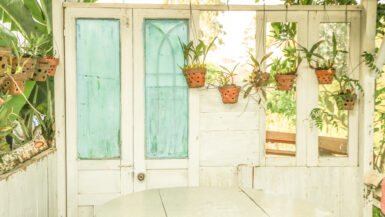Indoor vertical gardens have increasingly gained attention in recent years for their aesthetic appeal and the numerous benefits they provide. For individuals with disabilities, these innovative gardening solutions can be particularly transformative, offering a more accessible and inclusive approach to cultivating plants indoors.
This article will delve into the advantages of indoor vertical gardens for people with disabilities, focusing on improved mental well-being and enhanced physical health and how these unique gardening systems can help foster a sense of accomplishment and independence. Join us as we explore the inspiring world of vertical gardening and its potential to empower individuals with disabilities to pursue a greener and healthier lifestyle.
Adaptive Gardening Techniques and Tools
Indoor vertical gardening opens up a world of possibilities for individuals with disabilities, allowing them to participate in gardening activities with ease and enjoyment. Through adaptive gardening techniques and tools, people with disabilities can access the therapeutic benefits of gardening without the barriers that traditional gardening methods might present.
This section will discuss various adaptive gardening techniques and tools that can be especially beneficial for those with disabilities and how they can be incorporated into an indoor vertical garden.
Height-Adjustable Vertical Gardens
One key advantage of indoor vertical gardens is the ability to customize their height to suit individual needs. By using height-adjustable systems, people with disabilities can easily access the plants comfortably.
This eliminates the need for bending, reaching, or kneeling, making gardening more enjoyable and less physically demanding. For wheelchair users, a height-adjustable vertical garden can be tailored to the perfect height for easy access and maintenance.
Ergonomic Gardening Tools
Using ergonomic gardening tools can significantly improve the gardening experience for individuals with disabilities. These tools are designed with comfort and ease of use, minimizing strain on joints and muscles. From long-handled pruners to lightweight watering cans, ergonomic tools can make a difference in accessibility and enjoyment. Investing in high-quality, disability-friendly tools can help ensure the indoor vertical gardening experience is as smooth and enjoyable as possible.
Simple Plant Care Techniques
Indoor vertical gardens are typically low-maintenance by nature, making them an ideal option for individuals with disabilities. Choosing low-maintenance plant varieties requiring minimal attention can further simplify gardening.
Additionally, implementing easy plant care techniques, such as using self-watering systems or opting for soilless growing mediums like hydroponics, can make the upkeep of an indoor vertical garden more manageable. To learn more about indoor vertical garden maintenance, check out our article on How to Grow a Thriving Indoor Vertical Garden in Winter.
Accessible Garden Design
When designing an indoor vertical garden for individuals with disabilities, accessibility and ease of use must be considered. This might include factors such as the placement of plants, the width of pathways between vertical garden systems, and the arrangement of tools and supplies.
By thoughtfully designing the garden space to accommodate the individual’s specific needs and preferences, an indoor vertical garden can become a truly inclusive and empowering environment.
Ultimately, adaptive gardening techniques and tools can make indoor vertical gardening more accessible and enjoyable for individuals with disabilities. By embracing these strategies, people with disabilities can harness the many benefits of indoor vertical gardening, from improved mental well-being to enhanced physical health and a greater sense of accomplishment and independence.
Enhancing Mental Health through Indoor Gardening
Indoor vertical gardens offer myriad mental health benefits for individuals with disabilities. They provide a soothing and restorative environment that fosters relaxation and personal growth. In this subsection, we will explore how indoor gardening can positively impact mental well-being, touching on topics such as stress reduction, cognitive health, and the development of a nurturing mindset.
Stress Reduction and Emotional Well-being
The calming presence of plants and the process of tending to them have been shown to reduce stress and anxiety, promoting emotional well-being. For people with disabilities, indoor vertical gardens can serve as a sanctuary, offering a gentle escape from the challenges of daily life.
Nurturing plants can bring a sense of accomplishment and satisfaction, boosting self-esteem and overall happiness. Furthermore, the visually appealing nature of vertical gardens can elevate the ambiance of any space, creating a soothing atmosphere that promotes relaxation and mindfulness.
Cognitive Health and Mental Stimulation
Gardening is not only a physical activity but also a mentally stimulating one. Planning, designing, and maintaining an indoor vertical garden engages various cognitive skills, such as problem-solving, decision-making, and spatial awareness.
For individuals with disabilities, this mental stimulation can be especially beneficial, helping to maintain cognitive health and combat feelings of isolation or boredom. Moreover, learning about different plant species, their care requirements, and the science behind their growth can be an intellectually rewarding experience that fosters a lifelong love of learning.
Cultivating a Nurturing Mindset
Nurturing plants can teach valuable life skills like patience, responsibility, and empathy. For people with disabilities, indoor vertical gardening can be an empowering experience, allowing them to take control of their environment and develop a sense of agency.
Tending to a garden requires consistent care and attention, fostering a nurturing mindset that can extend to other areas of life. This growth-oriented approach to living can be particularly transformative for individuals with disabilities, encouraging them to view themselves as capable and resilient members of society.
Overall, the mental health benefits of indoor vertical gardening for people with disabilities are vast and varied. By engaging in this therapeutic activity, individuals with disabilities can experience stress reduction, cognitive stimulation, and the development of a nurturing mindset, all of which contribute to greater emotional well-being and personal growth.
Indoor vertical gardens beautify living spaces and provide an avenue for self-discovery and healing, making them a valuable addition to the lives of people with disabilities.
Improved Accessibility in Vertical Gardening
Indoor vertical gardens can offer a more inclusive and accessible approach to gardening for people with disabilities, breaking down barriers that traditional gardening methods may present. By adapting vertical gardens to suit individual needs, people with disabilities can enjoy the many benefits of gardening with greater ease and autonomy.
In this subsection, we will explore various aspects of accessibility in indoor vertical gardens, including space-saving designs, customized support systems, and the potential for social inclusion.
Space-Saving Designs for Limited Mobility
One of the primary appeals of indoor vertical gardens is their efficient use of space. These innovative systems allow cultivating diverse plants in a compact area, making them well-suited for individuals with limited mobility.
By minimizing the need for extensive movement, indoor vertical gardens enable people with disabilities to engage in gardening without straining their physical capabilities. This space-saving aspect is especially beneficial for wheelchair users or those with limited range of motion, as it allows for more straightforward navigation and plant access.
Customized Support Systems for Individual Needs
Indoor vertical gardens can be tailored to accommodate the unique needs of individuals with disabilities, offering customized support systems that enhance accessibility. For example, adjustable shelving or hanging systems allow for effortlessly modifying the garden’s height, ensuring that plants are within easy reach for all users.
Additionally, incorporating features like grab bars, handrails, or slip-resistant surfaces can provide extra stability and safety. By adapting the vertical garden design to suit specific preferences and requirements, people with disabilities can enjoy a more comfortable and empowering gardening experience.
Social Inclusion Through Community Gardening
Incorporating indoor vertical gardens into community spaces, such as schools, care facilities, or local centers, can provide an opportunity for social inclusion for people with disabilities. These shared gardening spaces can serve as a platform for collaboration, learning, and connection, fostering a sense of belonging and community spirit.
Participating in group gardening activities can help individuals with disabilities build meaningful relationships, develop social skills, and feel valued as contributors to a shared project. By promoting social inclusion by integrating indoor vertical gardens into community settings, people with disabilities can reap the benefits of gardening while also experiencing the joys of connecting with others.
In summary, improved accessibility is a key advantage of indoor vertical gardens for people with disabilities. They allow for more inclusive and enjoyable gardening experiences. Through space-saving designs, customized support systems, and social inclusion opportunities, indoor vertical gardens can empower individuals with disabilities to engage in gardening activities with greater ease and independence.
By embracing these accessible features, people with disabilities can unlock the many therapeutic benefits of gardening, ultimately enhancing their overall quality of life.
Indoor Vertical Gardens as Therapeutic Spaces
Indoor vertical gardens offer more than an innovative way to grow plants in limited spaces; they can also serve as therapeutic spaces for people with disabilities. These gardens’ soothing and therapeutic qualities can significantly enhance mental, emotional, and physical well-being.
In this subsection, we will delve into the various ways that indoor vertical gardens can function as therapeutic spaces, exploring the healing power of nature, the role of sensory engagement, and the potential for creative expression.
The Healing Power of Nature
Plants and natural elements have long been associated with health and well-being. This innate human affinity for nature, biophilia, can be harnessed in indoor vertical gardens to create a stimulating and calming environment.
For individuals with disabilities, this connection to nature can offer a much-needed respite from the challenges and stressors of daily life. Tending to plants and watching them grow can foster a sense of tranquility and satisfaction, helping to alleviate anxiety or depression.
Engaging the Senses for Holistic Healing
Indoor vertical gardens can provide a sensory-rich experience that engages all five senses, creating a more immersive and therapeutic environment. The vibrant colors, varied textures, and soothing scents of different plant species can stimulate the senses and promote relaxation.
For individuals with disabilities, this sensory engagement can be particularly beneficial, helping to sharpen cognitive function, enhance mood, and reduce stress levels. By carefully selecting a diverse array of plants that cater to different sensory preferences, an indoor vertical garden can become a truly holistic healing space.
Creative Expression and Personal Growth
Designing and maintaining an indoor vertical garden offers ample creative expression and personal growth opportunities. Individuals with disabilities can explore their artistic side by experimenting with various plant arrangements, color schemes, and decorative elements.
This creative process can be both empowering and therapeutic, allowing individuals to express their unique personalities and cultivate a sense of pride in their work. Moreover, the ongoing maintenance and care of the garden can instill a sense of responsibility and purpose, fostering personal growth and resilience.
As we have explored in this subsection, indoor vertical gardens have the potential to serve as therapeutic spaces for people with disabilities. By harnessing the healing power of nature, engaging the senses, and providing opportunities for creative expression, these innovative gardening systems can offer many physical, emotional, and mental health benefits.
By embracing the therapeutic potential of indoor vertical gardens, people with disabilities can create nurturing environments that foster well-being, personal growth, and a deeper connection to the natural world.
Boosting Nutrition and Independence for People with Disabilities
Indoor vertical gardens offer a unique opportunity for people with disabilities to grow fresh produce, enhancing their nutritional intake and sense of independence. In this subsection, we will explore how indoor vertical gardens can contribute to a healthier lifestyle and greater autonomy for individuals with disabilities, focusing on topics such as cultivating nutrient-rich plants, the benefits of homegrown produce, and fostering self-sufficiency.
Cultivating Nutrient-Rich Plants for Improved Health
Growing a diverse array of nutrient-rich plants in an indoor vertical garden can significantly enhance the dietary habits of individuals with disabilities. By carefully selecting plant varieties rich in vitamins, minerals, and other essential nutrients, people with disabilities can ensure they consume a well-balanced and nourishing diet.
Leafy greens, herbs, and edible flowers are some nutrient-dense plants that can thrive in an indoor vertical garden. Incorporating these homegrown plants into daily meals can positively impact overall health and well-being.
The Benefits of Fresh, Homegrown Produce
The freshness of homegrown produce has numerous advantages over store-bought alternatives, this can include higher nutrient content, better taste, and reduced exposure to pesticides and other harmful chemicals. For people with disabilities, having access to fresh, homegrown produce from their indoor vertical garden can be a game-changer regarding nutrition and overall health.
Additionally, consuming produce from the garden can be a more enjoyable and satisfying experience. This encourages individuals to eat more fruits and vegetables, leading to a healthier lifestyle.
Fostering Self-Sufficiency and Independence
Cultivating an indoor vertical garden can empower individuals with disabilities by giving them the tools and knowledge to grow their food. This sense of self-sufficiency and independence can be transformative, boosting confidence and fostering a greater understanding of agency in daily life.
By learning to care for their plants and harvest their produce, people with disabilities can develop valuable life skills that can be applied to various aspects of their lives. This increased independence can lead to a more fulfilling, self-determined lifestyle.
In this subsection, we have highlighted how indoor vertical gardens can improve nutrition and independence for people with disabilities. By cultivating nutrient-rich plants, enjoying the benefits of fresh, homegrown produce, and fostering self-sufficiency, individuals with disabilities can take charge of their health and well-being.
Indoor vertical gardens offer an innovative and accessible approach to gardening and provide a means for people with disabilities to enhance their quality of life through better nutrition and increased autonomy.







Leave a reply